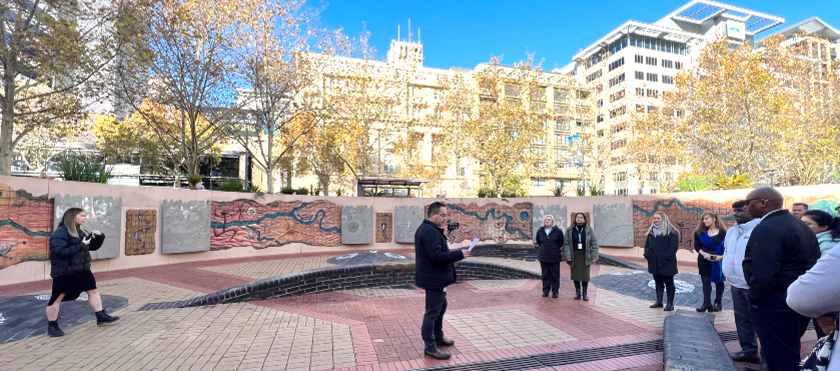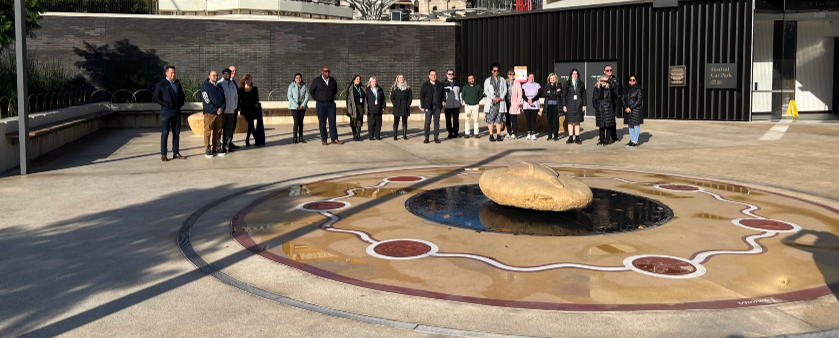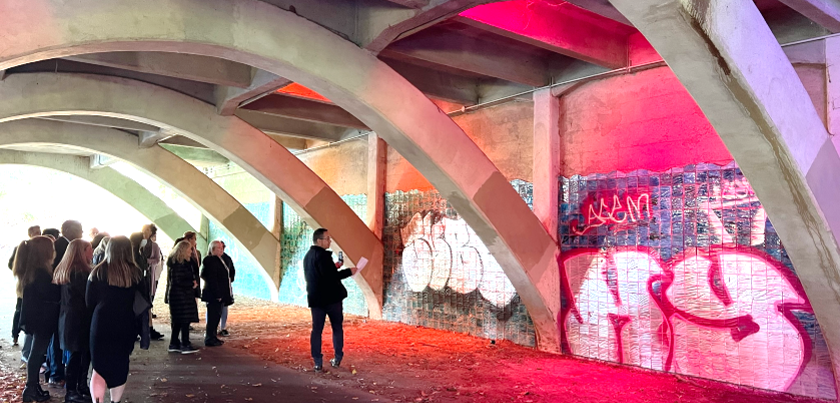Stop 1 - Yarakartarta (Yerrakartarta)
Location
Intercontinental Hotel
Forecourt
North Terrace
Adelaide
South Australia
About this artwork
Installed in 1995, Yerrakartarta (today spelled Yarakartarta) (meaning ‘at random’) was designed by Kookatha artist, Milika – Darryl Pfitzner, in consultation with Kaurna miyurna including Kaurna/Ngarrindjeri artist, Muriel Mumtherang van der Byl.
Muriel’s silk paintings of the stories of Kaurna Dreaming ancestor Tjilbruke and Ngarrindjeri Dreaming ancestor Ngurunderi, are translated here into ceramic tile murals.
Tjilbruke created the fresh water springs along the coast with his tears of grief, following his nephew’s death. Ngurunderi created the River Murray and cut up Pondi, the Murray Cod, to create all the different (fresh-water) fish.
Stop 2 - Old Parliament House + Parliament House + Government House
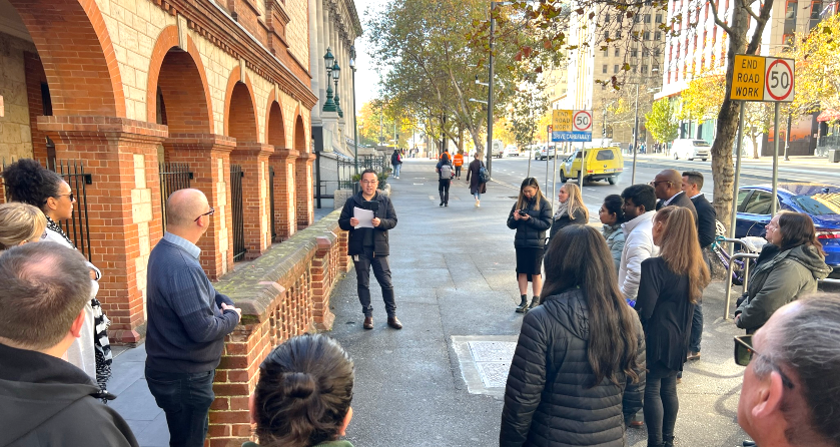
Photo | Old Parliament House
Locations
Old Parliament House
Corner North Terrace and Station Road
Adelaide
South Australia
Parliament House
North-West corner of North Terrace and King William Road
Adelaide
South Australia
Government House
North-Eastern corner of North Terrace and King William Road
Adelaide
South Australia
About these locations
Old Parliament House
It is believed that part of the Old Parliament House building, like the Holy Trinity Church, was built out of cream coloured stone quarried nearby from the sacred Tarnta Kanya (male Kangaroo) rock.
Parliament House
At Parliament House, the South Australian Parliament, in a bipartisan gesture on 28 May 1997, expressed its deep and sincere regret for the forced separation of some Aboriginal children from their families and homes, which occurred prior to 1964. Parliament apologised to Aboriginal people for these past actions and reaffirmed its support for Reconciliation between all Australians.
Government House
At Government House, Governor Gawler made a practice of having his speeches translated into Kaurna language. In a speech published in the Register on 27 October 1838, he said: ‘Black men – We wish to make you happy. But you cannot be happy unless you imitate good white men. Build huts, wear clothes, work and be useful. Above all things you cannot be happy unless you love GOD who made heaven and earth and men and all things. Love white man. Love other tribes of black men. Do not quarrel together. Tell other tribes to love white men, and to build good huts and wear clothes. Learn to speak English.’
Stop 3 - Kaurna Reconciliation Sculpture
Location
Adelaide Festival Centre
Festival Plaza
Western Side of King William Road
Approximately 200 metres North of the North Terrace Intersection
Located between Parliament House and Elder Park
Adelaide
South Australia
Sculpture Story
This Kaurna Reconciliation sculpture, dedicated to Kaurna in 2002, represents some of the Kaurna story, giving insight to Kaurna culture and history. It was designed in consultation with Kaurna community by Kaurna artist Eileen Karpany and Aboriginal artist Darren Siwes with Tony Rosella and sculpted by Donato Rosella.
Sculpture Elements
Tarnta Kanya (Red Kangaroo Rock)
Tarnta Kanya, the natural rock formation relating to the Red Kangaroo Dreaming of the Adelaide area, may well have been located on, or near, the Adelaide Festival Centre. This was the place where Tarnta, the male Red Kangaroo totemic ancestor introduced the men’s initiation ceremony.
Ngangkiparingga (Onkaparinga), Women’s River
Symbolised here within the oval shape of a woman’s large dish or bowl, is a form representing the flowing creeks and rivers as well as the inner curves of shellfish found in the fresh and salt water of Ngangkiparingga and other estuaries in Kaurna country.
Tjilbruke, the Ibis Man
The spiritual shape symbolises the fresh water springs and journey of Tjilbruke, the Ibis Man, a Kaurna creator ancestor. Tjilbruke helped create the Kaurna landscape while grieving for his nephew, Kulultuwi, who was killed after he broke a kuinyunta (taboo) forbidding him to eat kardi (emu).
Yuridla, Dreaming story of the Mount Lofty Ranges
The Dreaming of Ngarnu, the body of the giant from the east, is depicted in this sandstone sculpture. From the Adelaide parklands can be seen his two ears (Mount Lofty and Mount Bonython), called Yuridla – two ears (now known as Uraidla).
Kaurna Spiritual Beliefs
Elements of this artwork symbolise the great sky river Wardlipari (lit. ‘hut river’, commonly known as Milky Way) and the Yurdakauwi (lagoon in the dark parts of Wardlipari, belonging to the giant serpent Yurda).
Wardlipari was so named because Kaurna miyurna believe the bright stars on the edge to be campfires of ancestors along the edge of the river in the skyworld. The skyworld reflects life on earth. Life-sustaining fresh water is central to meeting places on earth and spiritually in the skyworld – past, present and in the future.
For some people today, the water represents tears linked to the Reconciliation process. The Kaurna shield (Wakalti) is a central element.
Stop 4 - 'You Are Standing on Kaurna Land' Mural
Location
City Bridge Underpass
Adelaide
South Australia
Mural Story
Many elements and themes are combined and draw on the environmental history of this location and reminds us that this was a place for Kaurna to hunt and gather their daily food.
On the tiles are depicted European fish such as carp (which have supplanted most of the now-vanished endemic fish species).
Also depicted are other animals and creatures that once lived around this part of the Torrens before it was dammed. Kaurna remember Gudgeon fish for example, that are no longer in the river but were a staple of their diet.
Stop 5 - 'Talking our way home' Artwork
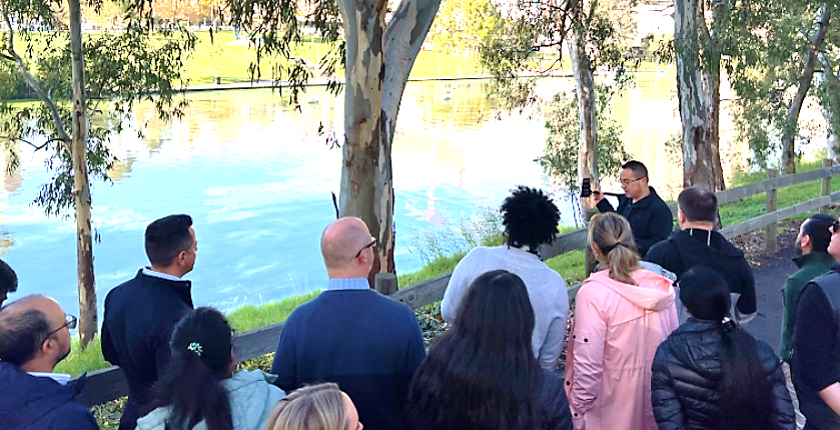
Location
Riverbank
War Memorial Drive
Opposite Memorial Drive + Adelaide Oval
Adelaide
South Australia
Artwork Story
The artwork is a historical and personal reflection on migration, dispossession and the role that language plays in creating a sense of identity and belonging. The inscribed glass and steel ‘floating paper boats’, draw on the handwritten letters of 19th and 20th century immigrants, and the experiences of the artist Shaun Kirby (a child migrant of the 1960s).
The shore-based element contains text developed in collaboration with the Kaurna language committee, Kaurna Warra Pintyanthi. Ngaiera karralika kauwingga taikutti yerra kumanendi (Nayirda karralika kauwingka taikuthi yara kumarninthi) ‘The sky and the outer world are connected in the waters and the two become one.’
Notes
Information provided via Adelaide City Council Adelaide Kaurna Walking Trail page : 1 June 2022


